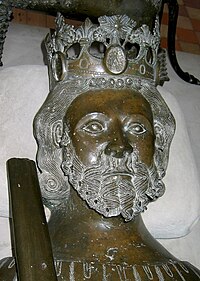Christoffer II
| Christopher II | |||||
|---|---|---|---|---|---|

Christopher II's tomb effigy at Sorø Abbey.
|
|||||
| King of Denmark | |||||
| Reign | 1320–1326 | ||||
| Coronation | 15 August 1324 Vordingborg |
||||
| Predecessor | Eric VI Menved | ||||
| Successor | Valdemar III | ||||
| Junior King | Eric Christoffersen | ||||
| King of Denmark | |||||
| Reign | 1330–1332 | ||||
| Predecessor | Valdemar III | ||||
| Successor | Vacant Valdemar IV Atterdag |
||||
| Junior King | Eric Christoffersen | ||||
| Born | 29 September 1276 | ||||
| Died | 2 August 1332 (aged 55) Nykøbing Castle |
||||
| Burial | Sorø Abbey | ||||
| Consort | Euphemia of Pomerania | ||||
| Issue among others... |
Margaret, Margravine of Brandenburg Eric Christoffersen Otto, Duke of Lolland and Estonia Valdemar IV Atterdag |
||||
|
|||||
| House | Estridsen | ||||
| Father | Eric V Klipping | ||||
| Mother | Agnes of Brandenburg | ||||
| Religion | Roman Catholicism | ||||
| Full name | |
|---|---|
| Christopher Eriksen |
Christopher II (Danish: Christoffer 2.; 29 September 1276 – 2 August 1332) was king of Denmark from 1320 to 1326 and again from 1329 until his death. He was son of Eric V. His name is connected with national disaster, as his rule ended in an almost total dissolution of the Danish state.
Being the brother of King Eric VI, Christopher was a possible heir to the throne. As a young man with the title of Duke of Estonia, he supported the politics of his brother. Among other things he arrested Archbishop Jens Grand in 1294. But later on he joined the opposition and went into exile at the death of Eric in 1319.
The magnates wanted a weak royal power, and Christopher was elected as king in January 1320; in return he signed a contractual håndfæstning, the first time this kind of document was used as a coronation charter. He received a "bankrupt estate" in which entire regions of the kingdom were mortgaged to German and Danish magnates. The conditions of the charter were very hard, because they limited his ability to assess taxes, as well as demanded payments on the mortgages. Christopher could make no decision regarding the realm without the consent of the nobility and the bishops. The privileges of the nobility and the church were included in the charter and new ones were included. No bishop could be imprisoned, exiled, or fined without the pope's approval, no secular court could try any churchman, no church land or property could be taxed, the nobles could raise fees or rents on peasants, no noble could be forced to fight abroad or forced to pay to outfit soldiers to fight abroad, the king was required to ransom captured noblemen within a year, all taxes imposed since the reign of Valdemar Sejr on nobles or church were to be lifted, but the kingdom's debts were to be paid. This shift of power away from the king would last until 1660.
Despite signing the charter, King Christopher ruled as if it did not exist. Since he could not tax the church or Danish nobles he levied disastrous taxes on the German territories and peasants.
During the next years Christopher tried to strengthen his position by reviving Erik’s policy of warfare against the duchies, counties, and cities of Northern Germany. This resulted in new mortgages and taxes, and very soon he was in conflict with both the church and the magnates. During a rebellion in 1326 he was overthrown by an alliance between Danish magnates and Holstein Count Gerhard III and Count Johann I of Holstein-Kiel (Count Johann I of Wagrien, son of Adolf IV of Holstein). Christopher was forced into abdication and exile, while the 12-year-old Duke Valdemar of Southern Jutland was made a king of Denmark under the regent, Count Gerhard. They forced the Valdemar in his coronation charter to separate southern Jutland from Denmark so that never again would the King of Denmark rule there. Knud Knudson Porse took Halland for himself for his services to Count Gerhard and Count Johann. The squabbling over who got which pieces of Denmark broke down the alliances which had forced Christopher out of the country.
...
Wikipedia
